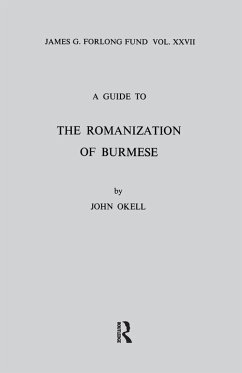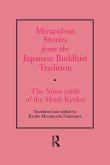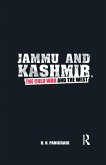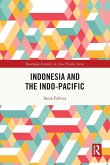John Okell
A Guide to the Romanization of Burmese
John Okell
A Guide to the Romanization of Burmese
- Broschiertes Buch
- Merkliste
- Auf die Merkliste
- Bewerten Bewerten
- Teilen
- Produkt teilen
- Produkterinnerung
- Produkterinnerung
This work covers the three methods of Romanization: transliteration (Duroiselle's system); transcription (early, conventional, IPA and typewritten types); and the combined method (Minn Latt's system).
Andere Kunden interessierten sich auch für
![Functional Structure(s), Form and Interpretation Functional Structure(s), Form and Interpretation]() Functional Structure(s), Form and Interpretation67,99 €
Functional Structure(s), Form and Interpretation67,99 €![Miraculous Stories from the Japanese Buddhist Tradition Miraculous Stories from the Japanese Buddhist Tradition]() Kyoko Motomuchi NakamuraMiraculous Stories from the Japanese Buddhist Tradition73,99 €
Kyoko Motomuchi NakamuraMiraculous Stories from the Japanese Buddhist Tradition73,99 €![A Sketch of the Modern Languages of the East Indies A Sketch of the Modern Languages of the East Indies]() Robert N CustA Sketch of the Modern Languages of the East Indies53,99 €
Robert N CustA Sketch of the Modern Languages of the East Indies53,99 €![Jammu and Kashmir, the Cold War and the West Jammu and Kashmir, the Cold War and the West]() D N PanigrahiJammu and Kashmir, the Cold War and the West65,99 €
D N PanigrahiJammu and Kashmir, the Cold War and the West65,99 €![Mixed Race Identities in Asia and the Pacific Mixed Race Identities in Asia and the Pacific]() Zarine L RochaMixed Race Identities in Asia and the Pacific43,99 €
Zarine L RochaMixed Race Identities in Asia and the Pacific43,99 €![Indonesia and the Indo-Pacific Indonesia and the Indo-Pacific]() Senia FebricaIndonesia and the Indo-Pacific55,99 €
Senia FebricaIndonesia and the Indo-Pacific55,99 €![Islam Outside the Arab World Islam Outside the Arab World]() Ingvar SvanbergIslam Outside the Arab World70,99 €
Ingvar SvanbergIslam Outside the Arab World70,99 €-
-
-
This work covers the three methods of Romanization: transliteration (Duroiselle's system); transcription (early, conventional, IPA and typewritten types); and the combined method (Minn Latt's system).
Produktdetails
- Produktdetails
- Verlag: Routledge
- Seitenzahl: 76
- Erscheinungstermin: 6. März 2002
- Englisch
- Abmessung: 216mm x 140mm x 4mm
- Gewicht: 109g
- ISBN-13: 9780947593322
- ISBN-10: 0947593322
- Artikelnr.: 22362742
- Herstellerkennzeichnung
- Libri GmbH
- Europaallee 1
- 36244 Bad Hersfeld
- gpsr@libri.de
- Verlag: Routledge
- Seitenzahl: 76
- Erscheinungstermin: 6. März 2002
- Englisch
- Abmessung: 216mm x 140mm x 4mm
- Gewicht: 109g
- ISBN-13: 9780947593322
- ISBN-10: 0947593322
- Artikelnr.: 22362742
- Herstellerkennzeichnung
- Libri GmbH
- Europaallee 1
- 36244 Bad Hersfeld
- gpsr@libri.de
Okell, John
1 PRELIMINARY 1.1 Introduction: scope of booklet. 1.2 Abbreviations. 2 THE PROBLEM. 2.1 Sound and symbol: transliteration
transcription and combined systems 2.2 Burmese and the roman alphabet: ways of filling the gaps 3 SURVEY OF THE THREE METHODS OF ROMANIZATION 3.1Transliteration method. 3.2 Transcription method. 3.3 Combined method 3.4 Summary 4 THE THREE METHODS IN DETAIL 4.1 Transliteration 4.1.1 Table 1: Duroiselle' s system 4.1.2 Notes and variants: fi
ai
o2
ui
special vowels
medials
finals
tone marks
punctuation
abbreviations
spacing
Sanskrit letters. 4.1.3 Summary 4.2 Transcription 4.2.1 Table 2: early
conventional
IPA
and typewritten types 4.2.2 Notes and variants: aspirate plosives
palatal affricates
voiced consonants
voiced dental fricative
hush sibilant
nasal consonants
glottal onset
vowels
finals
tones
voicing
spacing. 4.2.3 Summary. 4.3 Combined method. 4.3.1 Table 3: Minn Latt's system 4.3.2 Notes and variants : velar and palatal initials
aspirate plosives
voiced plosives
nj/nj
j/y/r etc
glottal onset
vowels
ut un etc
finals
tones
voicing and spacing. 4.3.3 Summary. 5 CONCLUSION: CHOICE OF SYSTEM. 6 BIBLIOGRAPHY. 7 REFERENCE TABLES. 7.1 Recommended systems. 7.1.1 Transliteration: Table 4: standard transliteration and variation: sim plified transliteration. 7.1.2 Transcription: Table 5: standard phonetic transcription with standard conventional transcription and variations: phonetic transcription witn voicing marked conventional transcription with accented tones conventional transcription with raised comma tones. 7.2 Major transcriptions in current use: Table 6: 1957 Sprigg
1955 Stewart
1944 Cornyn
1958 Cornyn
1969 Okell
1961 Ballard
1966 Library of Congress
1930 Government
1966 Minn Latt.
transcription and combined systems 2.2 Burmese and the roman alphabet: ways of filling the gaps 3 SURVEY OF THE THREE METHODS OF ROMANIZATION 3.1Transliteration method. 3.2 Transcription method. 3.3 Combined method 3.4 Summary 4 THE THREE METHODS IN DETAIL 4.1 Transliteration 4.1.1 Table 1: Duroiselle' s system 4.1.2 Notes and variants: fi
ai
o2
ui
special vowels
medials
finals
tone marks
punctuation
abbreviations
spacing
Sanskrit letters. 4.1.3 Summary 4.2 Transcription 4.2.1 Table 2: early
conventional
IPA
and typewritten types 4.2.2 Notes and variants: aspirate plosives
palatal affricates
voiced consonants
voiced dental fricative
hush sibilant
nasal consonants
glottal onset
vowels
finals
tones
voicing
spacing. 4.2.3 Summary. 4.3 Combined method. 4.3.1 Table 3: Minn Latt's system 4.3.2 Notes and variants : velar and palatal initials
aspirate plosives
voiced plosives
nj/nj
j/y/r etc
glottal onset
vowels
ut un etc
finals
tones
voicing and spacing. 4.3.3 Summary. 5 CONCLUSION: CHOICE OF SYSTEM. 6 BIBLIOGRAPHY. 7 REFERENCE TABLES. 7.1 Recommended systems. 7.1.1 Transliteration: Table 4: standard transliteration and variation: sim plified transliteration. 7.1.2 Transcription: Table 5: standard phonetic transcription with standard conventional transcription and variations: phonetic transcription witn voicing marked conventional transcription with accented tones conventional transcription with raised comma tones. 7.2 Major transcriptions in current use: Table 6: 1957 Sprigg
1955 Stewart
1944 Cornyn
1958 Cornyn
1969 Okell
1961 Ballard
1966 Library of Congress
1930 Government
1966 Minn Latt.
1 PRELIMINARY 1.1 Introduction: scope of booklet. 1.2 Abbreviations. 2 THE PROBLEM. 2.1 Sound and symbol: transliteration
transcription and combined systems 2.2 Burmese and the roman alphabet: ways of filling the gaps 3 SURVEY OF THE THREE METHODS OF ROMANIZATION 3.1Transliteration method. 3.2 Transcription method. 3.3 Combined method 3.4 Summary 4 THE THREE METHODS IN DETAIL 4.1 Transliteration 4.1.1 Table 1: Duroiselle' s system 4.1.2 Notes and variants: fi
ai
o2
ui
special vowels
medials
finals
tone marks
punctuation
abbreviations
spacing
Sanskrit letters. 4.1.3 Summary 4.2 Transcription 4.2.1 Table 2: early
conventional
IPA
and typewritten types 4.2.2 Notes and variants: aspirate plosives
palatal affricates
voiced consonants
voiced dental fricative
hush sibilant
nasal consonants
glottal onset
vowels
finals
tones
voicing
spacing. 4.2.3 Summary. 4.3 Combined method. 4.3.1 Table 3: Minn Latt's system 4.3.2 Notes and variants : velar and palatal initials
aspirate plosives
voiced plosives
nj/nj
j/y/r etc
glottal onset
vowels
ut un etc
finals
tones
voicing and spacing. 4.3.3 Summary. 5 CONCLUSION: CHOICE OF SYSTEM. 6 BIBLIOGRAPHY. 7 REFERENCE TABLES. 7.1 Recommended systems. 7.1.1 Transliteration: Table 4: standard transliteration and variation: sim plified transliteration. 7.1.2 Transcription: Table 5: standard phonetic transcription with standard conventional transcription and variations: phonetic transcription witn voicing marked conventional transcription with accented tones conventional transcription with raised comma tones. 7.2 Major transcriptions in current use: Table 6: 1957 Sprigg
1955 Stewart
1944 Cornyn
1958 Cornyn
1969 Okell
1961 Ballard
1966 Library of Congress
1930 Government
1966 Minn Latt.
transcription and combined systems 2.2 Burmese and the roman alphabet: ways of filling the gaps 3 SURVEY OF THE THREE METHODS OF ROMANIZATION 3.1Transliteration method. 3.2 Transcription method. 3.3 Combined method 3.4 Summary 4 THE THREE METHODS IN DETAIL 4.1 Transliteration 4.1.1 Table 1: Duroiselle' s system 4.1.2 Notes and variants: fi
ai
o2
ui
special vowels
medials
finals
tone marks
punctuation
abbreviations
spacing
Sanskrit letters. 4.1.3 Summary 4.2 Transcription 4.2.1 Table 2: early
conventional
IPA
and typewritten types 4.2.2 Notes and variants: aspirate plosives
palatal affricates
voiced consonants
voiced dental fricative
hush sibilant
nasal consonants
glottal onset
vowels
finals
tones
voicing
spacing. 4.2.3 Summary. 4.3 Combined method. 4.3.1 Table 3: Minn Latt's system 4.3.2 Notes and variants : velar and palatal initials
aspirate plosives
voiced plosives
nj/nj
j/y/r etc
glottal onset
vowels
ut un etc
finals
tones
voicing and spacing. 4.3.3 Summary. 5 CONCLUSION: CHOICE OF SYSTEM. 6 BIBLIOGRAPHY. 7 REFERENCE TABLES. 7.1 Recommended systems. 7.1.1 Transliteration: Table 4: standard transliteration and variation: sim plified transliteration. 7.1.2 Transcription: Table 5: standard phonetic transcription with standard conventional transcription and variations: phonetic transcription witn voicing marked conventional transcription with accented tones conventional transcription with raised comma tones. 7.2 Major transcriptions in current use: Table 6: 1957 Sprigg
1955 Stewart
1944 Cornyn
1958 Cornyn
1969 Okell
1961 Ballard
1966 Library of Congress
1930 Government
1966 Minn Latt.








